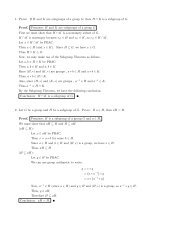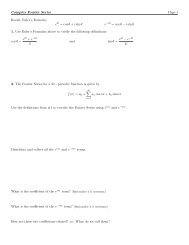Free Executive Summary - Elmhurst College
Free Executive Summary - Elmhurst College
Free Executive Summary - Elmhurst College
Create successful ePaper yourself
Turn your PDF publications into a flip-book with our unique Google optimized e-Paper software.
Learning to Think Spatially: GIS as a Support System in the K-12 Curriculum<br />
http://www.nap.edu/catalog/11019.html<br />
SPATIAL THINKING IN EVERYDAY LIFE, AT WORK, AND IN SCIENCE 63<br />
FIGURE 3.7 The Hertzsprung-Russell (H-R) diagram. Developed independently by the two astronomers for<br />
whom it is named, the H-R diagram shows absolute magnitude versus spectral type. Since the spectral type is<br />
a surrogate for temperature, hot blue stars are found on the left of the diagram and cool red stars on the right.<br />
The Sun is a star of intermediate temperature (G spectral type) with an absolute magnitude of approximately<br />
5. The group of stars running from upper left to lower right is called the main sequence and is where most<br />
stars are found on the diagram. A simple consideration of the Stefan Boltzman law suggests that a star above<br />
the main sequence at the same spectral type (temperature) must be large and one lower is smaller. This led to<br />
the designation of the stars in the upper right as red giants and those in the lower left as white dwarfs. Later<br />
work showed that the position in the H-R diagram was a product of stellar mass and age. The magnitude scale<br />
is a logarithmic scale of luminosity. Stars whose absolute magnitude differs by 5 differ in intrinsic luminosity<br />
by a factor of 100. SOURCE: Unsöld, 1969.<br />
which is simply the brightness of a star if it were placed at a standard distance of 10 parsecs.<br />
Examining the visible spectrum of a star and classifying it according to the observed distribution of<br />
features seen in its spectrum determines the spectral type of the star. Second, as ideas of modern<br />
quantum mechanics explained the reason for the existence of different spectral features in stellar<br />
spectra, it was realized that the star’s spectral type was a surrogate for temperature, so that the<br />
horizontal axis of the H-R diagram ran from hot blue stars on the left to cool red stars on the right.<br />
When spectral type and absolute magnitude were plotted, most stars were found to fall on a single<br />
broad band, called the main sequence, with some hot dim stars found below the main sequence and<br />
some cool bright stars found above. In one diagram, therefore, the concept of red giant and white<br />
dwarf stars was given meaning.<br />
Copyright © National Academy of Sciences. All rights reserved.












